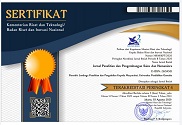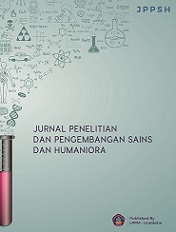Youtube Videos For Listening Skills During Covid-19 Pandemic: EFL Students’ Views
DOI:
https://doi.org/10.23887/jppsh.v6i3.55809Keywords:
YouTube, Listening, Online Learning, EFLAbstract
Social media acts as a source of information, entertainment media, discussion space, enriching learning resources, increasing creativity, and increasing student understanding, allowing students to create awareness about students' potential to become intellectually active. The most common social media used in EFL classrooms are Facebook, Whatsapp, YouTube, Instagram, and Twitter. Many have argued that YouTube provides authentic learning sources for improving students' English skills. Despite the availability and authenticity of YouTube videos to provide practice in enhancing students' listening skills, especially in an online setting, its application serves some challenges. The present study aimed to explore the students' perception of the application of YouTube in listening classes during online learning. This study was a qualitative study involving 32 university students. Data were collected from a questionnaire consisting of 31 items distributed through Google Form. The analysis resulted in students’ positive perception in the forms of four benefits: improving listening skills, increasing interest and motivation to learn, building critical thinking, and sharpening creativity. The identified shortcomings are the internet connection and the expensive internet credit. The present study confirms the usability of YouTube videos to practice students' listening skills, especially in online learning, where students need flexibility and creativity. However, it implies suggestions for stakeholders to provide stable and affordable internet connections so online learning can be conducted more effectively.
References
Adnyani, K. E. K., Adnyana, I. ., Murniasih, N. N., & Suwastini, N. K. A. (2022). Implementing Kahoot! for Japanese language learning in Indonesian high school. Journal of Education Technology, 6(2), 217–225. https://doi.org/10.23887/jet.v6i2.44674.
Amiryousefi, M. (2017). The incorporation of flipped learning into conventional classes to enhance EFL learners’ L2 speaking, L2 listening, and engagement. Innovation in Language Learning and Teaching, 13(2), 147–161. https://doi.org/10.1080/17501229.2017.1394307.
Apriansyah. (2020). Pemanfaatan Media Sosial Sebagai Media Pembelajaran pada Perguruan Tinggi di Sumsel. Jurnal Digital Teknologi Informasi, 1(2), 64–70. https://doi.org/10.32502/digital.v1i2.2371.
Ariantini, K. P., Suwastini, N. K. A., Adnyani, N. L. P. S., Dantes, G. R., & Jayantini, I. G. A. S. R. (2021). Integrating social media into English language learning: How and to what benefits according to recent studies. NOBEL: Journal of Literature and Language Teaching, 12(1), 91–111. https://doi.org/10.15642/NOBEL.2021.12.1.91-111.
Barrot, J. S., Llenares, I. I., & del Rosario, L. S. (2021). Students’ online learning challenges during the pandemic and how they cope with them: The case of the Philippines. Education and Information Technologies, 26(6). https://doi.org/10.1007/s10639-021-10589-x.
Binmahboob, T. (2020). YouTube as a learning tool to improve students’ speaking skills as perceived by EFL teachers in secondary school. International Journal of Applied Linguistics & English Literature, 9(6), 13–22. https://doi.org/10.7575/aiac.ijalel.v.9n.6p.13.
Broughton, G., Brumfit, C., Flavell, R., Hill, P., & Pincas, A. (1980). Teaching English as a foreign language. Routledge.
Cahyana, A. A. C. (2020). the Use of Youtube Video in Teaching English for Foreign Language At Vocational High School. Jurnal Pendidikan Bahasa Inggris Indonesia, 8(2), 1–11. https://doi.org/10.23887/jpbi.v8i2.3399.
Cahyani, N. M. W. S., Suwastini, N. K. A., Dantes, G. R., Jayantini, I. G. A. S. R., & Susanthi, I. G. A. A. D. (2021). Blended online learning: Combining the strengths of Synchronous and Asynchronous Online learning in EFL context. Jurnal Pendidikan Teknologi Dan Kejuruan, 18(2), 174–184. https://doi.org/http://dx.doi.org/10.23887/jptk-undiksha.v18i2.34659.
Chen, C. M., Li, M. C., & Lin, M. F. (2012). The effects of video-annotated learning and reviewing system with vocabulary learning mechanism on English listening comprehension and technology acceptance. Computer Assisted Language Learning, 35(7), 1557–1593. https://doi.org/10.1080/09588221.2020.1825093.
Chung, E., Subramaniam, G., & Dass, L. C. (2020). Online learning readiness among university students in Malaysia amidst Covid-19. Asian Journal of University Education, 16(2). https://doi.org/10.24191/AJUE.V16I2.10294.
Citrawati, N. K., Suwastini, N. K. A., Jayantini, I. G. A. S. R., Artini, N. N., & Dantes, G. R. (2021). Telegram as Social Networking Service (SNS) for enhancing students’ English: A systematic review. Journal of English Language Teaching and Linguistics, 6(2), 239–260. https://doi.org/10.21462/jeltl.v6i2.531.
Dantes, G. R., Audina, I. P., Marsakawati, N. P. E., & Suwastini, N. K. A. (2022). Investigating the Zoom application as a video conferencing platform in the online learning process based on teacher’s perception. Jurnal Nasional Pendidikan Teknik Informatika: JANAPATI, 11(2), 133–144. https://doi.org/10.23887/janapati.v11i2.48456.
Dantes, G. R., Rinawati, N. K. A., Suwastini, N. K. A., & Artini, N. N. (2022). Vocational school students ’ perceptions of Google Classroom in full online learning at the beginning of the covid-19 pandemic. Jurnal Pendidikan Teknologi Dan Kejuruan, 19(2), 86–94. https://doi.org/10.23887/jptkundiksha.v19i2.47917.
Diamandis, P., & Kotler, S. (2012). Abundance: The future is better than you think. Free Press.
Dörnyei, Z., & Taguchi, T. (2009). Questionnaires in second language research: Construction, administration, and processing: Second edition. In Questionnaires in Second Language Research: Construction, Administration, and Processing: Second Edition. https://doi.org/10.4324/9780203864739.
Elekaei, A., Tabrizi, H. H., & Chalak, A. (2020). A study into the impact of the choice of cognitive and meta-cognitive strategies and podcasts on vocabulary gain and retention levels in the telegram-based e-learning context. Teaching English with Technology, 20(2), 98–117. https://www.ceeol.com/search/article-detail?id=850515.
Hapsari, P., & Kusnindyah, P. (2020). Kemampuan Berpikir Tingkat Tinggi Dalam Pemanfaatan YouTube Sebagai Media Pembelajaran Bahasa Indonesia. In Jurnal Ilmiah Sekolah Dasar (Vols. 4, NumberH).
Huang, Y. M., & Hsieh, M. Y. (2020). An interdisciplinary research on students’ employability in technology education to advance higher education enrollment sustainability. Sustainability (Switzerland), 12(5). https://doi.org/10.3390/su12051806.
Koto, I. (2020). Teaching and Learning Science Using YouTube Videos and Discovery Learning in Primary School. Mimbar Sekolah Dasar, 7(1), 106–118. https://doi.org/10.17509/mimbar-sd.v7i1.22504.
Lestari, S. (2018). Peran Teknologi Dalam Pendidikan Di Era Globalisasi. EDURELIGIA: Jurnal Pendidikan Agama Islam, 2(2), 94–100. https://doi.org/10.33650/edureligia.v2i2.459.
Listiani, N. K. M., Suwastini, N. K. A., Dantes, G. R., Adnyani, N. L. P. S., & Jayantini, I. G. A. S. R. (2021). YouTube as digital learning resources for teaching bilingual young learners. Proceedings of the 2nd International Conference on Technology and Educational Science (ICTES 2020), 540(ICTES 2020), 156–162. https://doi.org/https://dx.doi.org/10.2991/assehr.k.210407.230.
Meinawati, E., Rahmah, N. A., Harmoko, D. D., & Dewi, N. (2020). Increasing English speaking skills through Youtube. POLYGLOT: Jurnal Ilmiah, 16(1), 1–13. https://doi.org/10.19166/pji.v16i1.1954.
Miles, M. B., Huberman, A. M., & Saldana, J. (2014). Qualitative data analysis: A methods sourcebook (3rd ed.). SAGE Publications Inc.
Mulyani, & Sartika, D. (2019). Analysis of Students’ Proficiency in English Pronunciation Using YouTube-Based Video Media. Getsempena English Education Journal (GEEJ), 6(2), 248–257. https://doi.org/10.46244/geej.v6i2.881.
Ningsih, N., & Arianti, A. (2019). The Usage of YouTube Video in Teaching English for Young Learner (TEYL) for Sixth Semester Students of English Department. Cordova Journal : Language and Culture Studies, 9(1), 1–16. https://doi.org/10.20414/cordova.v9i1.1773.
Nova, M. (2017). Utilizing Video for Technology Integration Support in Indonesian EFL Classroom: Usages and Obstacles. Indonesian Journal of EFL and Linguistics, 2(1), 15. https://doi.org/10.21462/ijefll.v2i1.28.
Nugroho, S. (2020). Upaya Penerapan Media YouTube dalam Peningkatan Keterampilan Menyimak Unsur Cerita Lisan. Sarasvati, 2(1). https://doi.org/10.30742/sv.v2i1.860.
Purwanti, N. K. R., Suwastini, N. K. A., Adnyani, N. L. P. S., & Kultsum, U. (2022). Youtube Videos for Improving Speaking Skills : The Benefits and Challenges According to Recent Research in EFL Context. Jurnal Pendidikan Teknologi Dan Kejuruan, 19(1), 66–75. https://doi.org/10.23887/jptk-undiksha.v19i1.41108.
Qomariyah, S. S., Permana, D., & Hidayatullah, H. (2021). The Effect of YouTube Video on Students’ Listening Comprehension Performance. Jo-ELT (Journal of English Language Teaching) Fakultas Pendidikan Bahasa & Seni Prodi Pendidikan Bahasa Inggris IKIP, 8(1), 67–73. https://doi.org/10.33394/jo-elt.v8i1.3837.
Rajulain, M. (2020). Students’ Self-Created YouTube Videos: A 21st Century Speaking Assessment. Diksi, 28(1), 15–23. https://doi.org/10.21831/diksi.v28i1.28290.
Ridwan, A., Firmansyah, M. B., & Rosyidah, I. (2021). Pemanfaatan Media Sosial Sebagai Media Pembelajaran Sastra di Era Digital. Prosiding Transformasi Pembelajaran Nasional (Pro-Tapenas), 1(1). https://ojs.uniwara.ac.id/index.php/protrapenas/article/view/227.
Riko, R., Lestari, F. A. P., & Lestari, I. D. (2020). Penggunaan Media Sosial Sebagai Media Pembelajaran Di Sekolah Menengah Pertama. Journal of Character Education Society, 3(2), 258–266. https://doi.org/10.31764/jces.v3i2.2310.
Rorimpandey, R. (2019). Video YouTube dalam Pengajaran Basic Listening. Abdimas: Jurnal Pengabdian Masyarakat, 12(2), 145–158. https://doi.org/10.36412/abdimas.v12i2.1052.
Saiful, J. A. (2019). EFL teachers’ cognition in the use of Youtube Vlog in English language teaching. Journal of Foreign Language Education and Technology, 4(1), 72–91. https://www.ceeol.com/search/article-detail?id=781396.
Sakkir, G., Dollah, S., & Ahmad, J. (2020). Students’ Perceptions toward Using YouTube in EFL Classrooms. Journal of Applied Science, Engineering, Technology, and Education, 2(1), 1–10. https://doi.org/10.35877/454RI.asci2125.
Salam, U. (2020). The Students’ Use of Google Classroom in Learning English. JPI (Jurnal Pendidikan Indonesia), 9(4), 628–638. https://doi.org/10.23887/jpi-undiksha.v9i4.27163.
Sari, F. M., & Wahyudin, A. Y. (2019). Undergraduate Students’ Perceptions Toward Blended Learning through Instagram in English for Business Class. International Journal of Language Education, 3(1), 64–73. https://eric.ed.gov/?id=EJ1244402.
Setiadi, E. F., Azmi, A., & Indrawadi, J. (2019). Youtube Sebagai Sumber Belajar Generasi Milenial. Journal of Civic Education, 2(4). https://doi.org/10.24036/jce.v2i4.135.
Shafwati, D., Sholihah, L., Prakoso, G. H., & Riyantika, F. (2021). The Use of YouTube Video toward Students’ Listening Ability. In ICOPE 2020: Proceedings of the 2nd International Conference on Progressive Education, ICOPE 2020, 16-17 October 2020, Universitas Lampung, Bandar Lampung, Indonesia. https://doi.org/10.4108/eai.16-10-2020.2305198.
Silviyanti, T. M. (2014). Looking into EFL students’ perceptions in listening by using English movie videos on YouTube. Studies in English Language and Education, 1(1), 42. https://doi.org/10.24815/siele.v1i1.1119.
Solano, L., Cabrera-Solano, P., Ulehlova, E., & Espinoza-Celi, V. (2020). Using EFL Youtube videos as supplementary resource for teaching vocabulary. The 5th International Conference on Information and Education Innovations, 40–45. https://doi.org/10.1145/3411681.3411682.
Suwastini, N. K. A., Nalantha, I. M. D., & Dantes, G. R. (2021). The Effectiveness of Google Classroom Media in Teaching English for Tourism at a Tourism and Business Institute. IJEE (Indonesian Journal of English Education), 8(2), 259–280. https://doi.org/10.15408/ijee.v8i2.21932.
Syafiq, A. N., Rahmawati, A., Anwari, A., & Oktaviana, T. (2021). Increasing speaking skill through YouTube video as English learning material during online learning in pandemic covid-19. Elsya: Journal of English Language Studies, 3(1), 50–55. https://doi.org/10.31849/elsya.v3i1.6206.
Trilling, B., & Fadel, C. (2009). 21st Century Skills: Learning for Life in Our Times. John Wiley.
Umayah, U., & Riwanto, M. A. (2020). Transformasi Sekolah Dasar Abad 21 New Digital Literacy untuk Membangun Karakter Siswa Di Era Global. JURNAL PANCAR (Pendidik Anak Cerdas Dan Pintar), 4(1), 1–10. https://ejournal.unugha.ac.id/index.php/pancar/article/view/308.
Yuyun, I., & Simamora, F. Y. (2021). The Use of YouTube to Support EFL Students’ Listening Skills. ELLTER Journal, 2(2), 1–12. https://doi.org/10.22236/ellter.v2i2.7512.
Downloads
Published
Issue
Section
License
Copyright (c) 2022 Ira Putri Audina, Luh Putu Artini, Ni Luh Putu Eka Sulistia Dewi, Ni Komang Arie Suwastini

This work is licensed under a Creative Commons Attribution-ShareAlike 4.0 International License.
Authors who publish with the Jurnal Penelitian dan Pengembangan Sains dan Humaniora agree to the following terms:
- Authors retain copyright and grant the journal the right of first publication with the work simultaneously licensed under a Creative Commons Attribution License (CC BY-SA 4.0) that allows others to share the work with an acknowledgment of the work's authorship and initial publication in this journal.
- Authors are able to enter into separate, additional contractual arrangements for the non-exclusive distribution of the journal's published version of the work (e.g., post it to an institutional repository or publish it in a book), with an acknowledgment of its initial publication in this journal.
- Authors are permitted and encouraged to post their work online (e.g., in institutional repositories or on their website) prior to and during the submission process, as it can lead to productive exchanges, as well as earlier and greater citation of published work. (See The Effect of Open Access)









